Decreasing Net Primary Productivity in Response to Urbanization in Liaoning Province, China
Abstract
:1. Introduction
2. Materials and Methods
2.1. Study Area
2.2. Data Collection
2.3. Characterization of Land Use/Cover Change (LUCC)
2.4. Simulation of Net Primary Productivity (NPP) Using the Carnegie–Ames–Stanford (CASA) Model
2.5. Analysis of the Impacts of Urbanization on NPP
3. Results
3.1. LUCC in Liaoning Province
3.2. Impact of Climate on NPP Change
3.3. The Response of NPP to LUCC
3.3.1. Variations of NPP under Different Types of Land Use
3.3.2. Variations in NPP Due to Urbanization
4. Discussion
4.1. Validation of the NPP Calculations
4.2. Effect of "Grain to Green" Project on NPP Variation
4.3. The Role of Climate Variation in Causing the NPP Change
4.4. Loss of NPP Caused by LUCC and Sustainable Development
5. Conclusions
- (1)
- Land use change was characterized by loss of farmland through urban expansion, and the rate of urbanization increased from 2000–2005 to 2005–2010.
- (2)
- Annual cumulative precipitation is found to be the dominant climatic factor that controls variability in NPP throughout the Liaoning province.
- (3)
- NPP of arid area in the western Liaoning and woodland area in eastern Liaoning tended to be more influenced by meteorological factors. Land use change was the most important factor driving changes in NPP in central Liaoning urban agglomeration, with lesser impacts from changes in climate.
- (4)
- Consistent with land use change in the urbanization process, the NPP decreased form 2000–2010 in the central area of the eight representative cities.
Acknowledgments
Author Contributions
Conflicts of Interest
References
- Vitousek, P.M.; Mooney, H.A.; Lubchenco, J.; Melillo, J.M. Human domination of Earth’s ecosystems. Science 1997, 277, 494–499. [Google Scholar] [CrossRef]
- Alberti, M. The effects of urban patterns on ecosystem function. Int. Reg. Sci. Rev. 2005, 28, 168–192. [Google Scholar] [CrossRef]
- Wackernagel, M.; Yount, J.D. The ecological footprint: An indicator of progress toward regional sustainability. Environ. Monit. Assess. 1998, 51, 511–529. [Google Scholar] [CrossRef]
- Pielke, R.A., Sr.; Walko, R.L.; Steyaert, L.T.; Vidale, P.L.; Liston, G.E.; Lyons, W.A.; Chase, T.N. The influence of anthropogenic landscape changes on weather in South Florida. Mon. Weather Rev. 1999, 127, 1663–1673. [Google Scholar] [CrossRef]
- Imhoff, M.L.; Tucker, C.J.; Lawrence, W.T.; Stutzer, D.C. The use of multisource satellite and geospatial data to study the effect of urbanization on primary productivity in the United States. IEEE Trans. Geosci. Remote Sens. 2000, 38, 2549–2556. [Google Scholar]
- Li, C.; Zhao, J. Spatiotemporal variations of vegetation NPP and related driving factors in Shiyang River basin of Northwest China in 2000–2010. Chin. J. Ecol. 2013, 32, 712–718. [Google Scholar]
- Wang, X.C.; Wang, S.D.; Zhang, H.B. Spatiotemporal pattern of vegetation net primary productivity in Henan Province of China based on MOD17A3. Chin. J. Ecol. 2013, 32, 2797–2805. [Google Scholar]
- Mohan, M.; Kandya, A. Impact of urbanization and land-use/land-cover change on diurnal temperature range: A case study of tropical urban airshed of India using remote sensing data. Sci. Total Environ. 2015, 506–507, 453–465. [Google Scholar] [CrossRef] [PubMed]
- Nelson, J.A.; Atzori, F.; Gastrich, K.R. Repeatability and phenotypic plasticity of fish swimming performance across a gradient of urbanization. Environ. Biol. Fish 2015, 98, 1431–1447. [Google Scholar] [CrossRef]
- Pan, J.; Liu, J.; Zhu, C. Budgeting carbon for urbanization in China. Wiley Interdiscip. Rev. Energy Environ. 2015, 4, 406–409. [Google Scholar] [CrossRef]
- Field, C.B.; Behrenfeld, M.J.; Randerson, J.T.; Falkowski, P. Primary production of the biosphere: Integrating terrestrial and oceanic components. Science 1998, 281, 237. [Google Scholar] [CrossRef] [PubMed]
- Long, P.S.; Fang, J.Y.; Chen, A.P. Seasonal dynamics of terrestrial net primary production in response to climate changes in China. Acta. Bot. Sin. 2003, 45, 269–275. [Google Scholar]
- Hemming, D.; Betts, R.; Collins, M. Sensitivity and uncertainty of modelled terrestrial net primary productivity to doubled CO2 and associated climate change for a relatively large perturbed physics ensemble. Agric. For. Meteorol. 2013, 170, 79–88. [Google Scholar]
- Peng, S.S.; Piao, S.L.; Shen, Z.H.; Ciais, P.; Sun, Z.Z.; Chen, S.P.; Chen, A.P. Precipitation amount, seasonality and frequency regulate carbon cycling of a semi-arid grassland ecosystem in Inner Mongolia, China: A modeling analysis. Agric. For. Meteorol. 2013, 178, 46–55. [Google Scholar] [CrossRef]
- Gough, C.M.; Flower, C.E.; Vogel, C.S.; Dragoni, D.; Curtis, P.S. Whole-ecosystem labile carbon production in a north temperate deciduous forest. Agric. For. Meteorol. 2009, 149, 1531–1540. [Google Scholar] [CrossRef]
- Wang, Y.P.; Houlton, B.Z. Nitrogen constraints on terrestrial carbon uptake: Implications for the global carbon-climate feedback. Geophys. Res. Lett. 2009, 36, 392–395. [Google Scholar] [CrossRef]
- Wu, S.; Zhou, S.; Chen, D.; Wei, Z.; Liang, D.; Li, X. Determining the contributions of urbanisation and climate change to NPP variations over the last decade in the Yangtze River Delta, China. Sci. Total Environ. 2014, 472, 397–406. [Google Scholar] [CrossRef] [PubMed]
- Liu, C.Y.; Dong, X.F.; Liu, Y.Y. Changes of NPP and their relationship to climate factors based on the transformation of different scales in Gansu, China. Catena 2015, 125, 190–199. [Google Scholar] [CrossRef]
- Imhoff, M.L.; Lawrence, W.T.; Elvidge, C.D.; Paul, T.; Levine, E.; Privalsky, M.V.; Brown, V. Using nighttime DMSP/OLS images of city lights to estimate the impact of urban land use on soil resources in the United States. Remote Sens. Environ. 1997, 59, 105–117. [Google Scholar] [CrossRef]
- Imhoff, M.L.; Bounoua, L.; Ricketts, T. Global patterns in human consumption of net primary production. Nature 2004, 429, 870–873. [Google Scholar] [CrossRef] [PubMed]
- Milesi, C.; Elvidge, C.D.; Nemani, R.R.; Running, S.W. Assessing the impact of urban land development on net primary productivity in the southeastern United States. Remote Sens. Environ. 2003, 86, 401–410. [Google Scholar] [CrossRef]
- Imhoff, M.L.; Bounoua, L.; DeFries, R.; Lawrence, W.T.; Stutzer, D.; Tucker, C.J.; Ricketts, T. The consequences of urban land transformation on net primary productivity in the United States. Remote Sens. Environ. 2004, 89, 434–443. [Google Scholar] [CrossRef]
- Lu, D.; Xu, X.; Tian, H.; Moran, E.; Zhao, M.; Running, S. The effects of urbanization on net primary productivity in Southeastern China. Environ. Manag. 2010, 46, 404–410. [Google Scholar] [CrossRef] [PubMed]
- Seto, K.C.; Burak, G.; Hutyra, L.R. Global forecasts of urban expansion to 2030 and direct impacts on biodiversity and carbon pools. PNAS 2012, 109, 16083–16088. [Google Scholar] [CrossRef] [PubMed]
- Tian, G.; Zhi, Q. Assessing the impact of the urbanization process on net primary productivity in China in 1989–2000. Environ. Pollut. 2013, 184C, 320–326. [Google Scholar] [CrossRef] [PubMed]
- Jiang, C.; Wu, Z.F.; Cheng, J.; Yu, Q.; Rao, X.Q. Impacts of urbanization on net primary productivity in the Pearl River Delta, China. Inter. J. Plant Prod. 2015, 9, 581–598. [Google Scholar]
- Yu, D.; Shao, H.; Shi, P.; Zhu, W.; Pan, Y. How does the conversion of land cover to urban use affect net primary productivity? A case study in Shenzhen city, China. Agric. For. Meteorol. 2009, 149, 2054–2060. [Google Scholar]
- Pei, F.; Li, X.; Liu, X.; Wang, S.; He, Z. Assessing the differences in net primary productivity between pre- and post-urban land development in China. Agric. For. Meteorol. 2013, 171–172, 174–186. [Google Scholar] [CrossRef]
- Zhang, F.; Pu, L.; Huang, Q. Quantitative Assessment of the Human Appropriation of Net Primary Production (HANPP) in the Coastal Areas of Jiangsu, China. Sustainability 2015, 7, 15857–15870. [Google Scholar] [CrossRef]
- Chen, A.; Li, R.; Wang, H. Quantitative assessment of human appropriation of aboveground net primary production in China. Ecol. Model. 2015, 312, 54–60. [Google Scholar] [CrossRef]
- Morgan, K.; Brebbia, C.A.; Spector, J.M. Human Appropriation of Net Primary Production (HANPP) in an Agriculturally-Dominated Watershed, Southeastern USA. Land 2015, 4, 513–540. [Google Scholar]
- Pan, Y.; Yu, C.; Zhang, X. A modified framework for the regional assessment of climate and human impacts on net primary productivity. Ecol. Indic. 2016, 60, 184–191. [Google Scholar] [CrossRef]
- Fathizad, H.; Rostami, N.; Faramarzi, M. Detection and prediction of land cover changes using Markov chain model in semi-arid rangeland in western Iran. Environ. Monit. Assess. 2015, 187. [Google Scholar] [CrossRef] [PubMed]
- Gong, W.F.; Yuan, L.; Fan, W.Y.; Stott, P. Analysis and simulation of land use spatial pattern in Harbin prefecture based on trajectories and cellular automata–Markov modelling. Int. J. Appl. Earth Obs. Geoinf. 2015, 34, 207–216. [Google Scholar] [CrossRef]
- Hao, C.; Zhang, J.H.; Li, H.Y.; Yao, F.M.; Huang, H.C.; Meng, W.Q. Integration of multinomial-logistic and Markov-Chain models to derive land-use change dynamics. J. Urban Plann. Dev. 2015, 141. [Google Scholar] [CrossRef]
- Potter, C.S.; Rerson, J.T.; Field, C.B.; Matson, P.A.; Vitousek, P.M.; Mooney, H.A.; Klooster, S.A. Terrestrial ecosystem production: A process model based on global satellite and surface data. Glob. Biogeochem. Cycles 1993, 7, 811–841. [Google Scholar] [CrossRef]
- Field, C.B.; Randerson, J.T.; Malmström, C.M. Global net primary production: Combining ecology and remote sensing. Remote Sens. Environ. 1995, 51, 74–88. [Google Scholar] [CrossRef]
- Zhu, W.Q.; Pan, Y.Z.; Zhang, J.S. Estimation of net primary productivity of Chinese terrestrial vegetation based on remote sensing. Chin. J. Plant Ecol. 2007, 31, 413–424. [Google Scholar]
- Peng, S.L.; Guo, Z.H.; Wang, B.S. Use of GIS and RS to estimate the light utilization efficiency of the vegetation in Guangdong, China. Acta Ecol. Sin. 2000, 20, 903–909. (In Chinese) [Google Scholar]
- Raymond, E.; Hunt, J.R. Relationship between woody biomass and PAR conversion efficiency for estimating net primary production from NDVI. Int. J. Remote Sens. 1994, 15, 1725–1730. [Google Scholar]
- Ruimy, A.; Saugier, B. Methodology for the estimation of terrestrial net primary production from remotely sensed data. J. Geophys. Res. 1994, 97, 18515–18521. [Google Scholar] [CrossRef]
- Goetz, S.J.; Prince, S.D. Remote sensing of net primary production boreal forest stands. Agric. For. Meteorol. 1996, 78, 149–179. [Google Scholar] [CrossRef]
- Paruelo, J.M.; Epstei, H.E.; Lauenroth, W.K. ANPP estimates from NDVI for the central grassland region of the United States. Ecology 1997, 78, 953–958. [Google Scholar] [CrossRef]
- McCrady, R.L.; Jokela, E.J. Canopy dynamics, light interception, and radiation use efficiency of selected loblolly pine families. For. Sci. 1998, 44, 64–72. [Google Scholar]
- Zhu, W.Q.; Pan, Y.Z.; He, T.; Yu, D.Y.; Hu, H.B. Simulation of maximum light use efficiency for some typical vegetation types in China. Chin. Sci. Bull. 2006, 51, 457–463. [Google Scholar] [CrossRef]
- Thornthwaite, C.W. An approach toward a rational classification of climate. Geogr. Rev. 1948, 38, 55–89. [Google Scholar] [CrossRef]
- Yi, K.P.; Zeng, Y.; Wu, B.F. Mapping and evaluation the process, pattern and potential of urban growth in china. Appl. Geogr. 2016, 71, 44–55. [Google Scholar] [CrossRef]
- Friendly, M. Corrgrams: Exploratory Displays for Correlation Matrices. Am. Stat. 2002, 56, 316–324. [Google Scholar] [CrossRef]
- Guo, Z.X.; Wang, Z.M.; Zhang, B.; Liu, D.W.; Yang, G.; Song, K.S.; Li, F. Analysis of temporal-spatial characteristics and factors influencing vegetation NPP in Northeast China from 2000 to 2006. Res. Sci. 2008, 30, 1226–1235. [Google Scholar]
- Zhao, G.S.; Wang, J.B.; Fan, W.Y.; Ying, T.Y. Vegetation net primary productivity in Northeast China in 2000–2008: Simulation and seasonal change. Chin. J. Appl. Ecol. 2011, 22, 621–630. [Google Scholar]
- Cheng, C.X.; Xu, Z.X.; Wang, Z.H.; Liu, C.M. Temporal-spatial change simulation and analysis of net primary productivity in northeast china from 2001 to 2010. Res. Sci. 2014, 36, 2401–2412. [Google Scholar]
- Gang, C.C.; Wang, Z.Q.; Zhou, W.; Chen, Y.Z.; Li, J.L.; Cheng, J.M.; Chen, C. Projecting the dynamics of terrestrial net primary productivity in response to future climate change under the RCP2.6 scenario. Environ. Earth Sci. 2015, 74, 5949–5959. [Google Scholar] [CrossRef]
- Grindean, R.; Feurdean, A.; Hurdu, B.; Farcas, S.; Tantau, I. Lateglacial/Holocene transition to mid-Holocene: Vegetation responses to climate changes in the Apuseni Mountains (NW Romania). Quatern. Int. 2015, 388, 76–86. [Google Scholar] [CrossRef]
- Li, S.S.; Lu, S.H.; Gao, Y.H.; Ao, Y.H. The change of climate and terrestrial carbon cycle over Tibetan Plateau in CMIP5 models. Int. J. Climatol. 2015, 35, 4359–4369. [Google Scholar] [CrossRef]
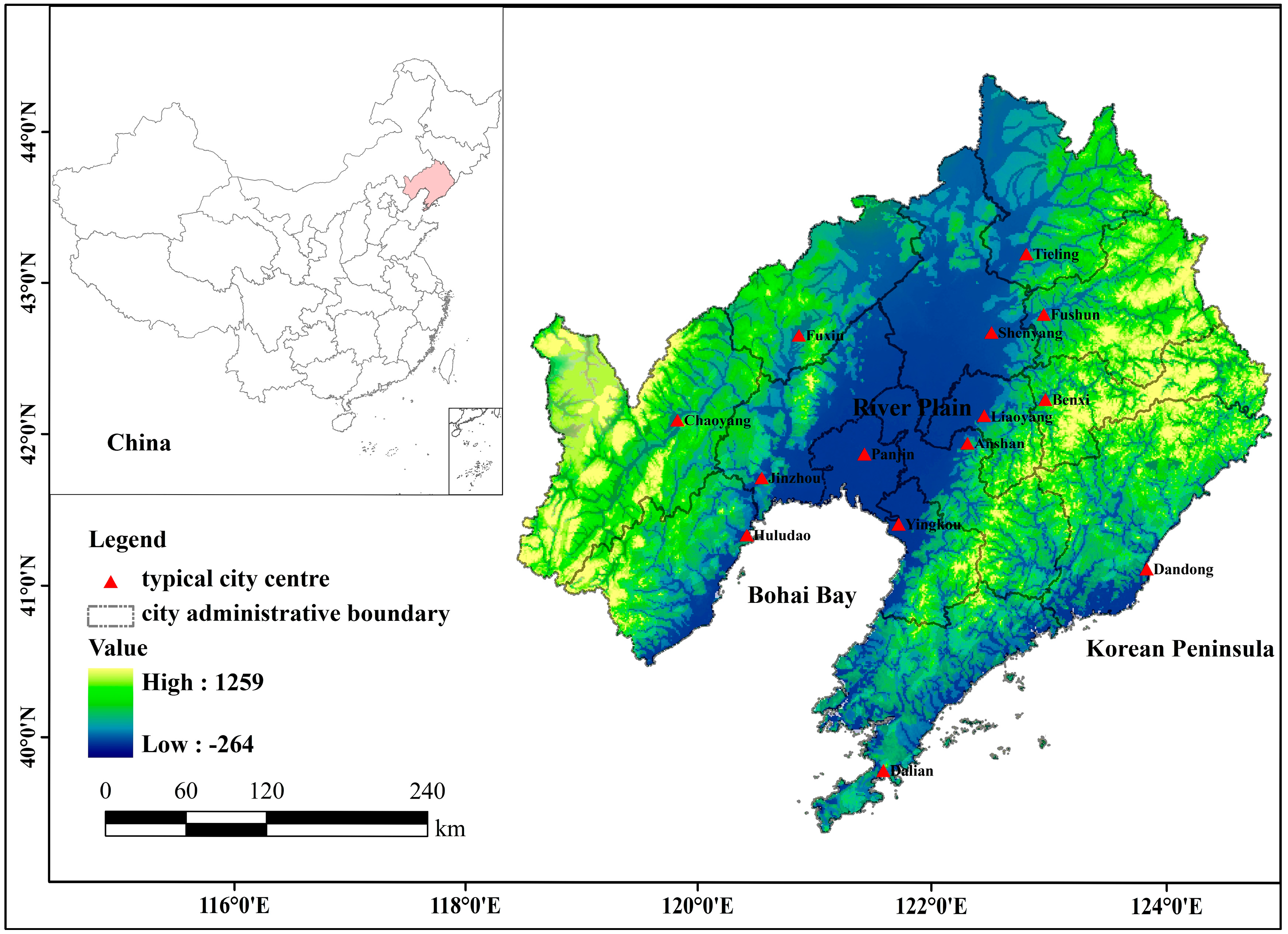
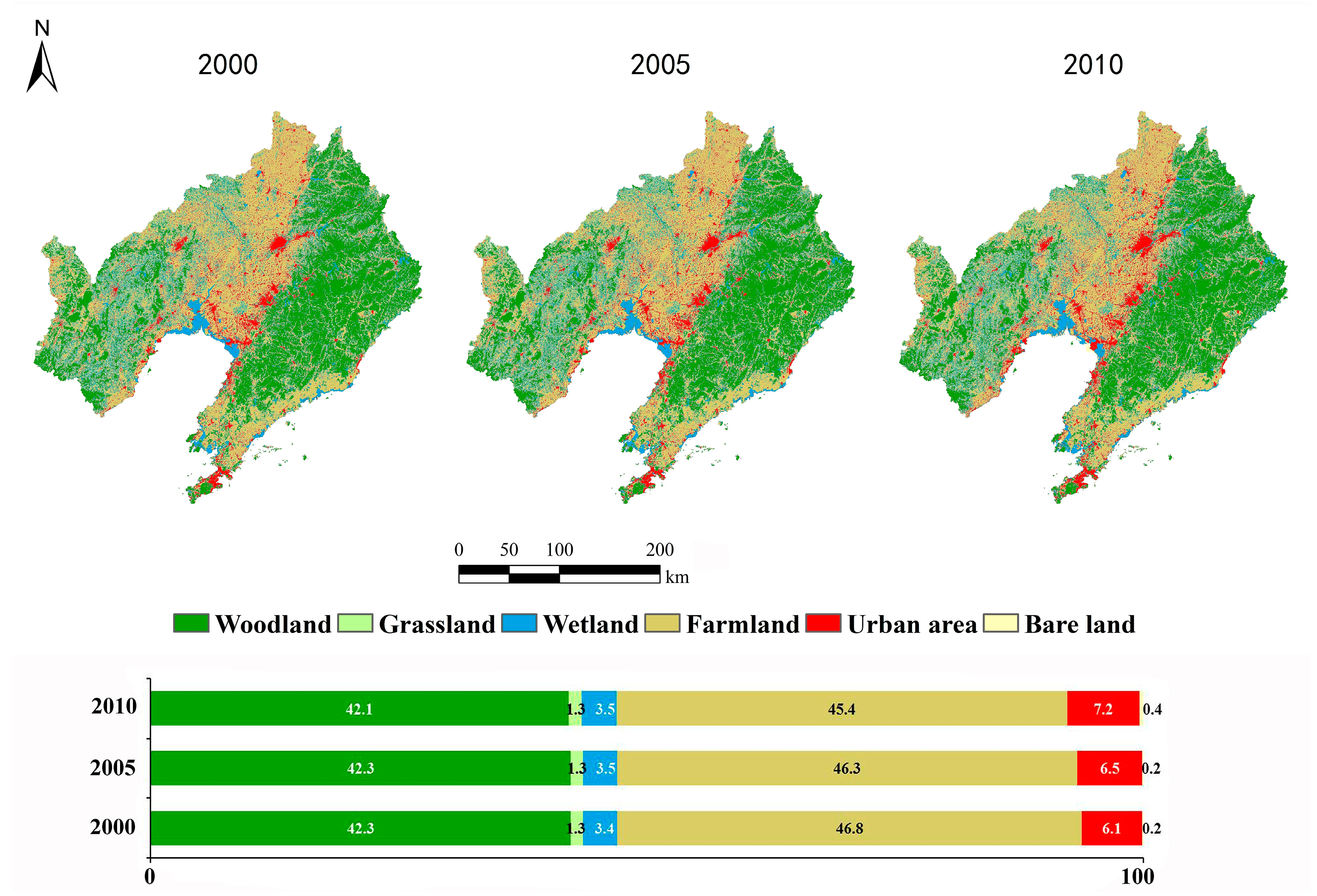

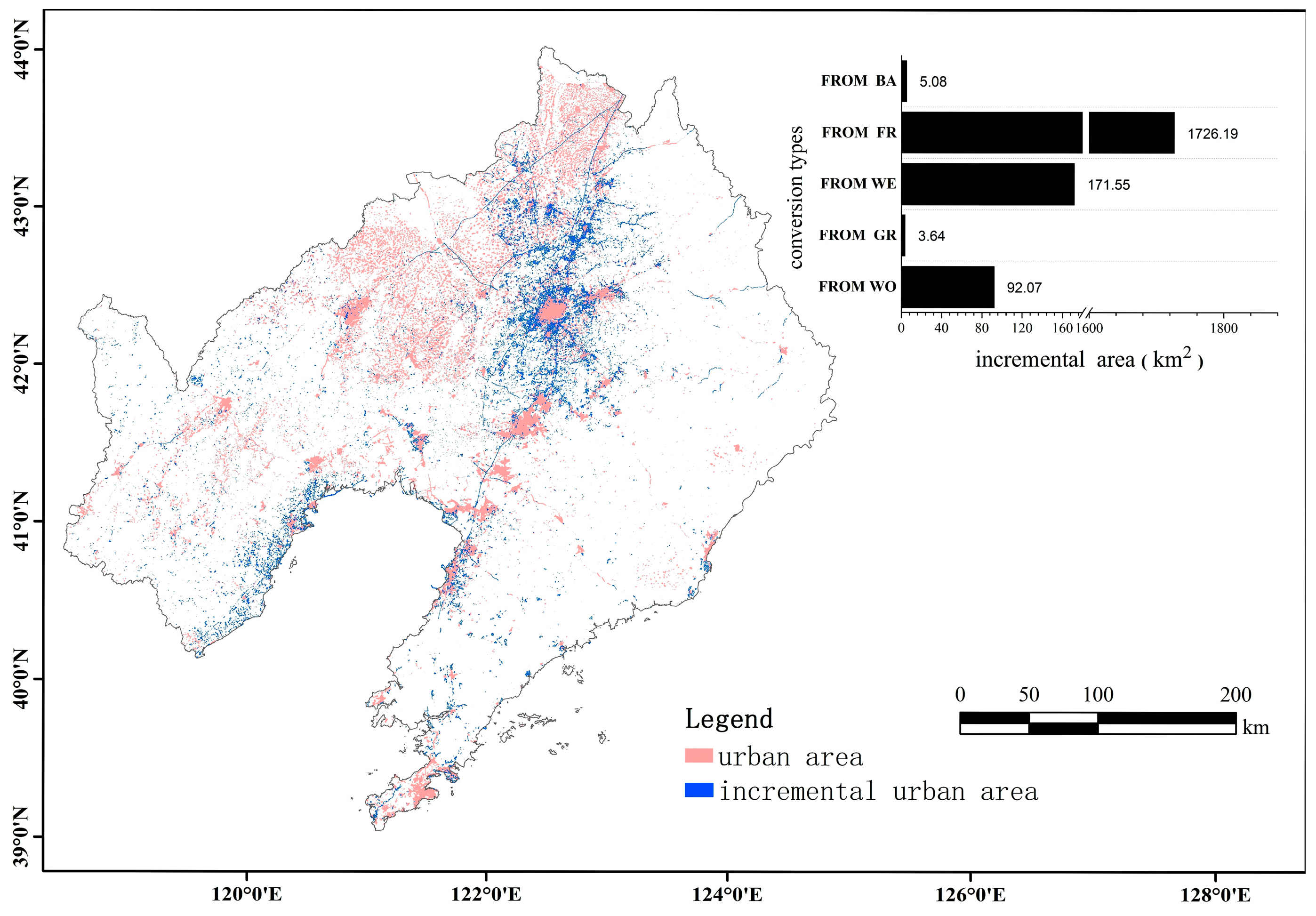
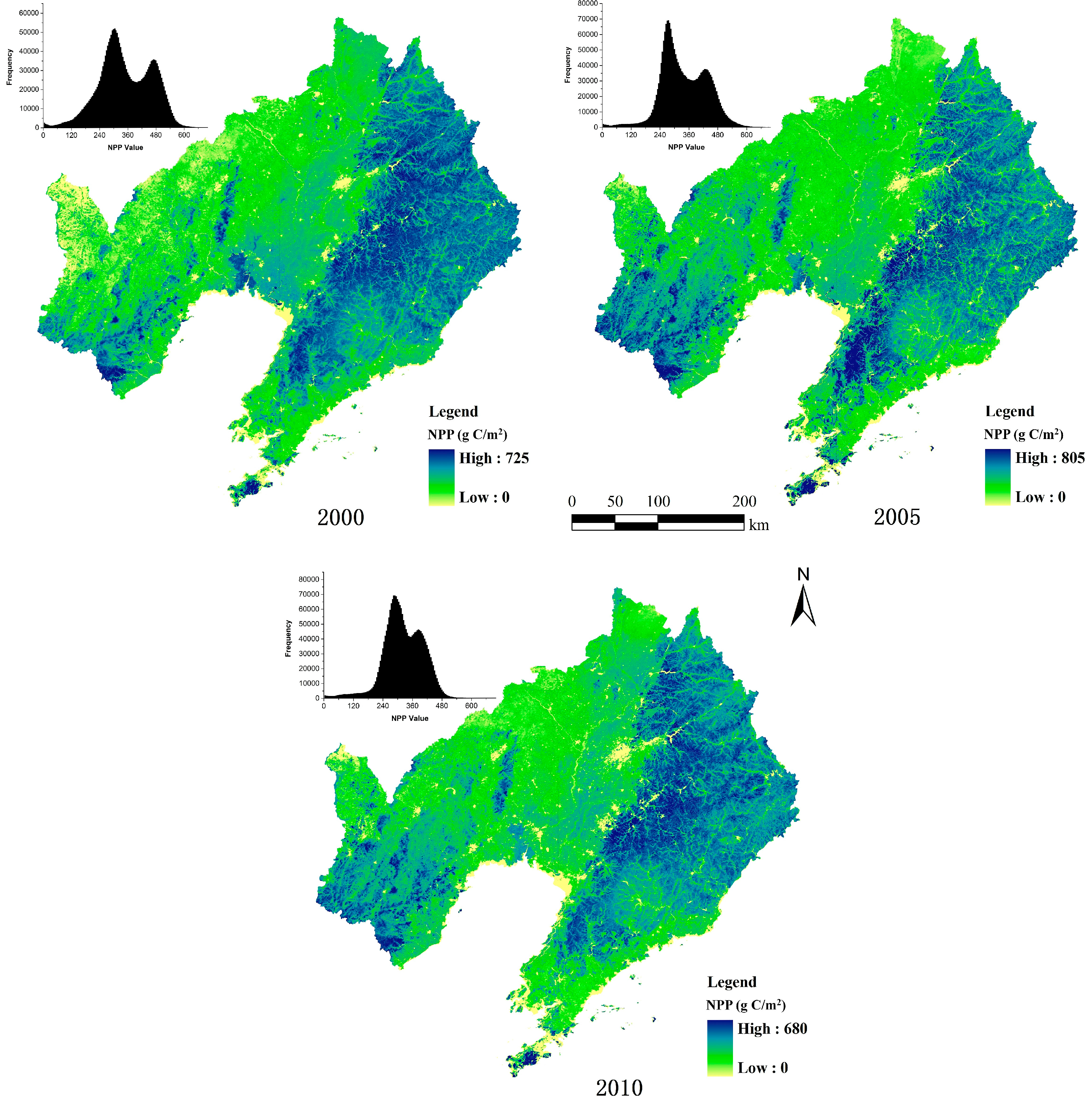

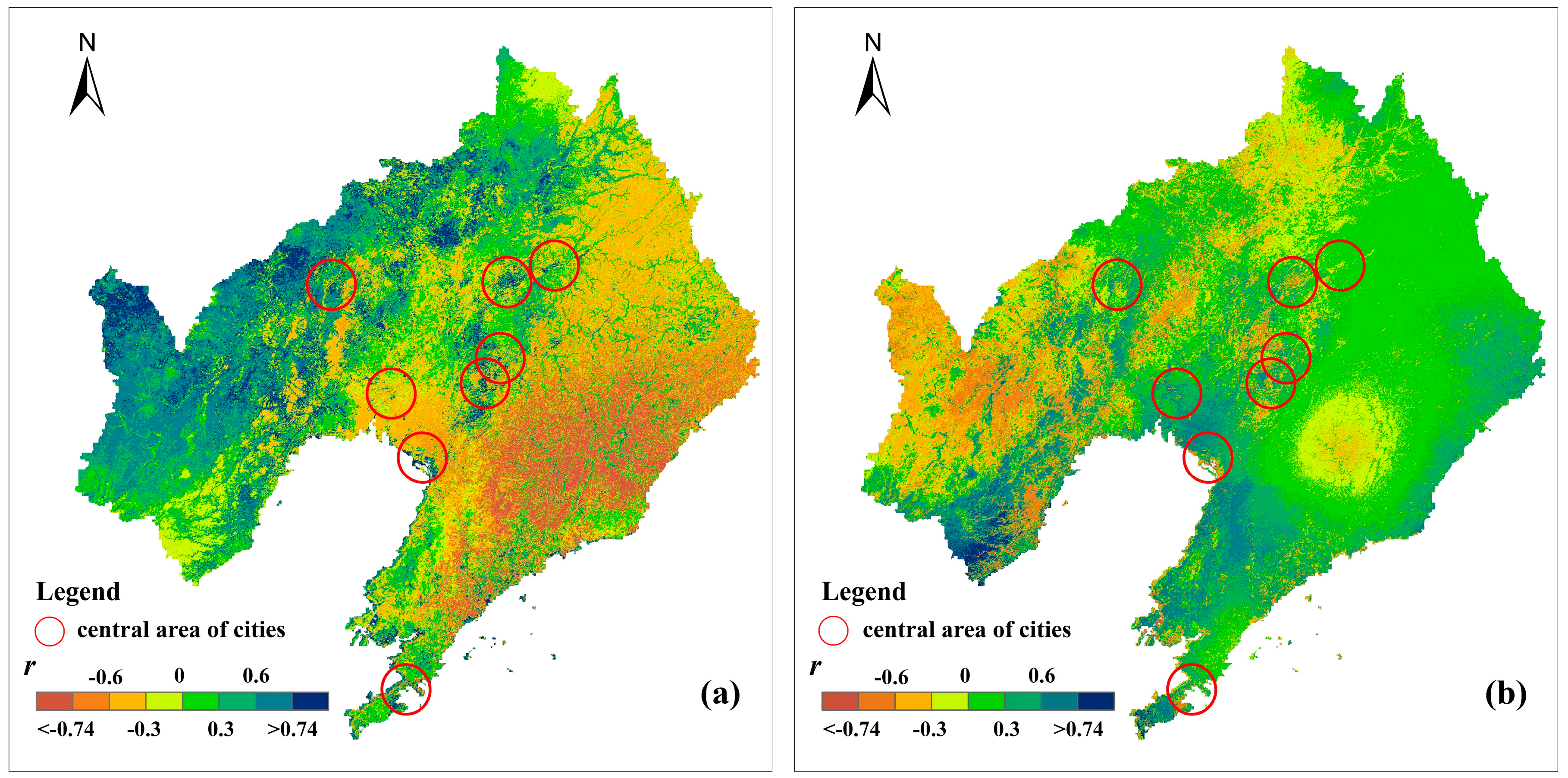
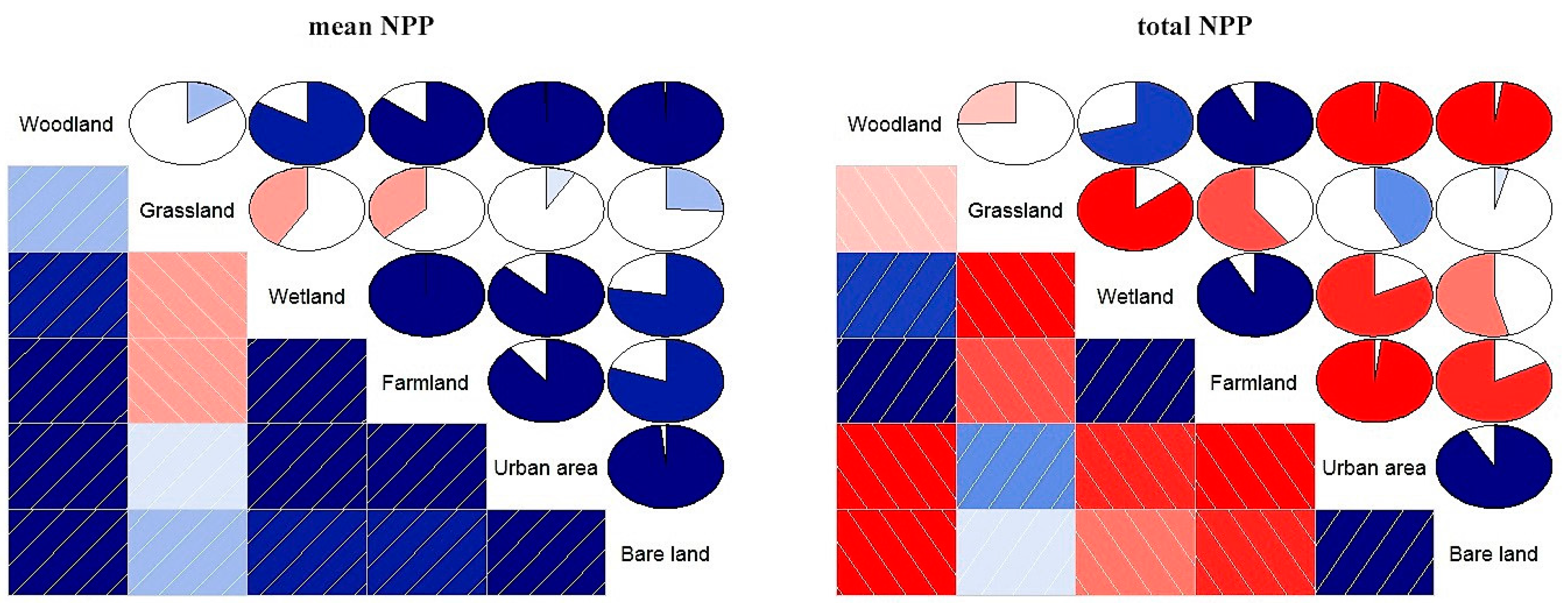
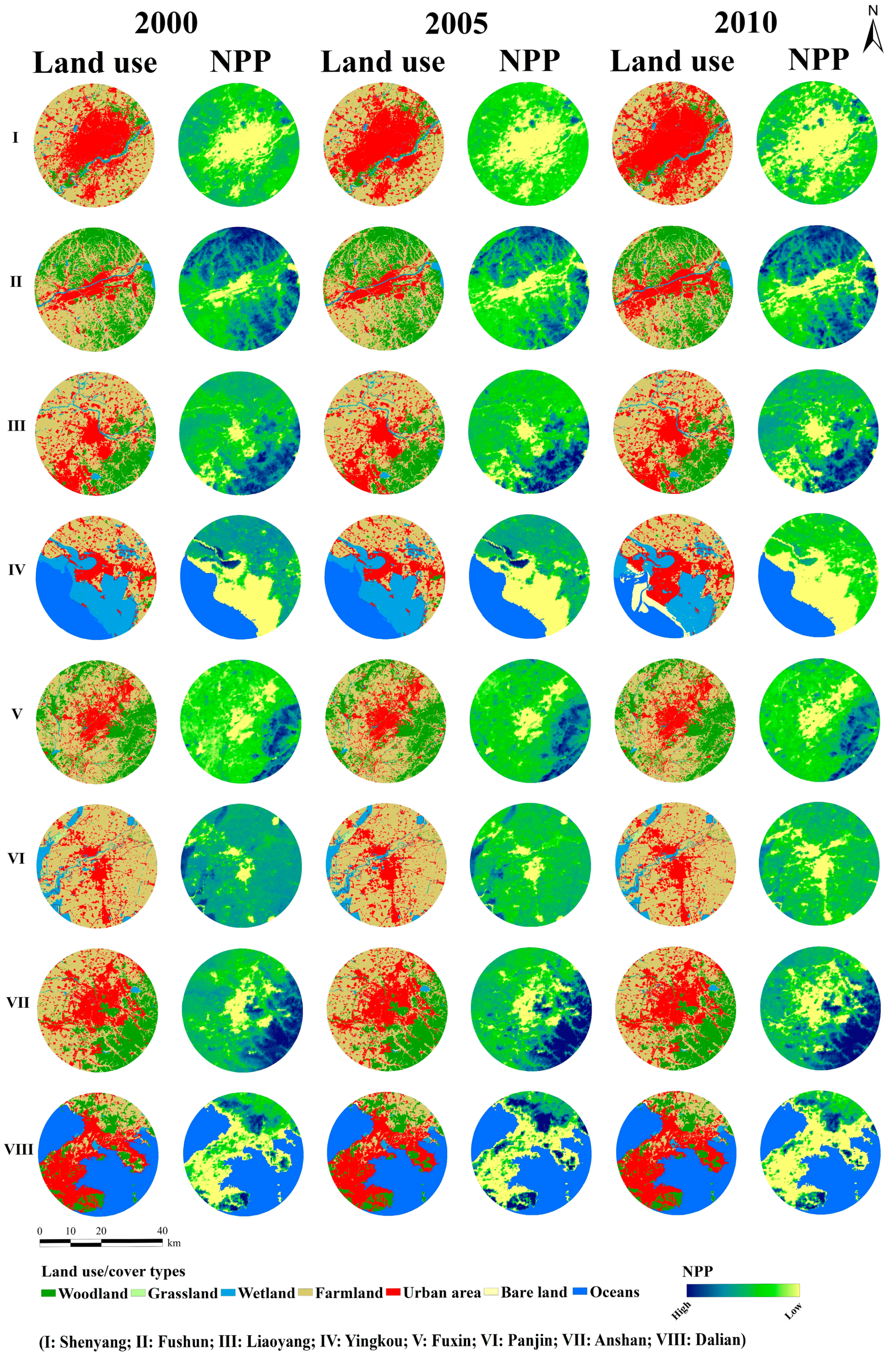

| Year | Land Use Type | Woodland | Grassland | Wetland | Farmland | Urban Area | Bare Land | Total Change |
|---|---|---|---|---|---|---|---|---|
| 2000–2005 | Woodland | 61,139.47 | 44.84 | 16.14 | 572.02 | 68.17 | 2.59 | 703.76 |
| Grassland | 51.47 | 1754.25 | 1.58 | 30.55 | 2.82 | 0.32 | 86.74 | |
| Wetland | 22.52 | 1.16 | 4814.38 | 94.80 | 43.23 | 5.76 | 167.47 | |
| Farmland | 585.68 | 43.69 | 123.21 | 66,907.37 | 741.99 | 12.63 | 1507.20 | |
| Urban area | 40.34 | 2.59 | 10.48 | 186.67 | 8613.02 | 0.90 | 240.98 | |
| Bare land | 1.98 | 0.29 | 4.42 | 6.21 | 1.65 | 241.89 | 14.55 | |
| 2720.70 | ||||||||
| 2005–2010 | Woodland | 61,688.91 | 7.36 | 9.97 | 116.09 | 19.47 | 4.19 | 157.08 |
| Grassland | 10.49 | 1830.74 | 0.25 | 5.00 | 0.58 | 0.07 | 16.39 | |
| Wetland | 4.33 | 2.61 | 4810.91 | 71.01 | 129.80 | 41.29 | 249.04 | |
| Farmland | 113.36 | 44.24 | 109.88 | 66,475.89 | 1002.48 | 55.84 | 1325.80 | |
| Urban area | 7.94 | 1.64 | 10.65 | 33.71 | 9425.32 | 2.84 | 56.78 | |
| Bare land | 0.43 | 3.03 | 2.61 | 1.97 | 3.97 | 265.28 | 12.01 | |
| 1817.10 | ||||||||
| 2000–2010 | Woodland | 60,991.43 | 52.04 | 25.42 | 675.52 | 92.07 | 6.85 | 851.90 |
| Grassland | 61.50 | 1738.83 | 1.79 | 34.73 | 3.64 | 0.48 | 102.14 | |
| Wetland | 26.20 | 3.73 | 4576.38 | 159.70 | 171.55 | 45.28 | 406.46 | |
| Farmland | 692.04 | 87.28 | 225.97 | 65,616.09 | 1726.19 | 67.08 | 2798.56 | |
| Urban area | 47.54 | 4.13 | 20.28 | 206.52 | 8572.40 | 3.67 | 282.14 | |
| Bare land | 2.37 | 3.28 | 5.57 | 7.01 | 5.08 | 233.47 | 23.31 | |
| 4464.51 |
| City | r(Pre)* PN | r(Tem)* PN | Total PN | PCT-Pre Ratio | PCT-Tem Ratio |
|---|---|---|---|---|---|
| Shenyang | 228 | 160 | 20,100 | 1.13 | 0.80 |
| Fushun | 20 | 18 | 20,100 | 0.10 | 0.09 |
| Anshan | 434 | 251 | 20,100 | 2.16 | 1.25 |
| Yingkou | 184 | 299 | 15,207 | 1.21 | 1.97 |
| Fuxin | 301 | 133 | 20,100 | 1.50 | 0.66 |
| Panjin | 28 | 37 | 20,100 | 0.14 | 0.18 |
| Dalian | 641 | 114 | 11,434 | 5.61 | 1.00 |
| Liaoyang | 259 | 245 | 20,100 | 1.29 | 1.22 |
| Land Use Type | Mean NPP (g C/m2/y) | Total NPP (Tg C/y) | ||||
|---|---|---|---|---|---|---|
| 2000 | 2005 | 2010 | 2000 | 2005 | 2010 | |
| Woodland | 418.20 | 407.10 | 376.40 | 25.86 | 25.18 | 23.28 |
| Grassland | 305.75 | 325.70 | 308.10 | 0.56 | 0.60 | 0.58 |
| Wetland | 241.95 | 218.00 | 211.40 | 1.21 | 1.10 | 1.10 |
| Farmland | 305.80 | 296.35 | 293.05 | 20.92 | 20.09 | 19.55 |
| Urban area | 252.45 | 244.25 | 227.75 | 2.23 | 2.32 | 2.42 |
| Bare land | 226.05 | 221.80 | 200.30 | 0.06 | 0.06 | 0.13 |
| Total area | 342.46 | 333.36 | 317.40 | 50.85 | 49.35 | 47.06 |
| City | Urban Area (km2) | % | NPP (g C/m2/y) | % | ||
|---|---|---|---|---|---|---|
| 2000 | 2010 | △UA | 2000 | 2010 | △NPP | |
| Shenyang | 477.07 | 660.55 | 38.46 | 254.26 | 218.66 | −14.00 |
| Fushun | 178.69 | 250.82 | 40.36 | 366.96 | 316.10 | −13.86 |
| Anshan | 354.17 | 373.69 | 5.51 | 344.97 | 315.75 | −8.47 |
| Yingkou | 201.87 | 289.28 | 43.30 | 257.77 | 180.80 | −29.86 |
| Fuxin | 213.69 | 225.31 | 5.44 | 267.65 | 273.63 | 2.23 |
| Panjin | 228.08 | 257.71 | 12.99 | 360.95 | 276.38 | −23.43 |
| Dalian | 362.30 | 390.55 | 7.80 | 228.71 | 197.60 | −13.60 |
| Liaoyang | 293.68 | 347.18 | 18.22 | 333.45 | 303.81 | −8.89 |
| Land Use Type | This Study | MOD17A3 | Cheng et al., 2014 [51] | Zhu et al., 2007 [38] | Guo et al., 2008 [49] | Zhao et al., 2011 [50] |
|---|---|---|---|---|---|---|
| Woodland | 400.57 | 393.17 | 344.32 | 367–985 | 370–470 | 538 ± 173 |
| Grassland | 313.18 | 332.01 | 256.86 | 226.20 | 312.45 | 310.45 |
| Wetland | 223.78 | 220.54 | 160.46 | 375.40 | 432.90 | —— |
| Farmland | 298.40 | 337.62 | 282.18 | 426.50 | 378.21 | 424.21 |
| Urban area | 241.48 | 252.57 | 211.38 | 347.10 | —— | —— |
| Bare land | 216.05 | 210.96 | 170.22 | 80.90 | —— | —— |
© 2017 by the authors. Licensee MDPI, Basel, Switzerland. This article is an open access article distributed under the terms and conditions of the Creative Commons Attribution (CC BY) license ( http://creativecommons.org/licenses/by/4.0/).
Share and Cite
Chen, T.; Huang, Q.; Liu, M.; Li, M.; Qu, L.; Deng, S.; Chen, D. Decreasing Net Primary Productivity in Response to Urbanization in Liaoning Province, China. Sustainability 2017, 9, 162. https://doi.org/10.3390/su9020162
Chen T, Huang Q, Liu M, Li M, Qu L, Deng S, Chen D. Decreasing Net Primary Productivity in Response to Urbanization in Liaoning Province, China. Sustainability. 2017; 9(2):162. https://doi.org/10.3390/su9020162
Chicago/Turabian StyleChen, Tan, Qiuhao Huang, Miao Liu, Manchun Li, Le’an Qu, Shulin Deng, and Dong Chen. 2017. "Decreasing Net Primary Productivity in Response to Urbanization in Liaoning Province, China" Sustainability 9, no. 2: 162. https://doi.org/10.3390/su9020162
APA StyleChen, T., Huang, Q., Liu, M., Li, M., Qu, L., Deng, S., & Chen, D. (2017). Decreasing Net Primary Productivity in Response to Urbanization in Liaoning Province, China. Sustainability, 9(2), 162. https://doi.org/10.3390/su9020162






